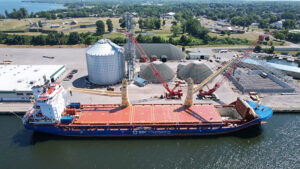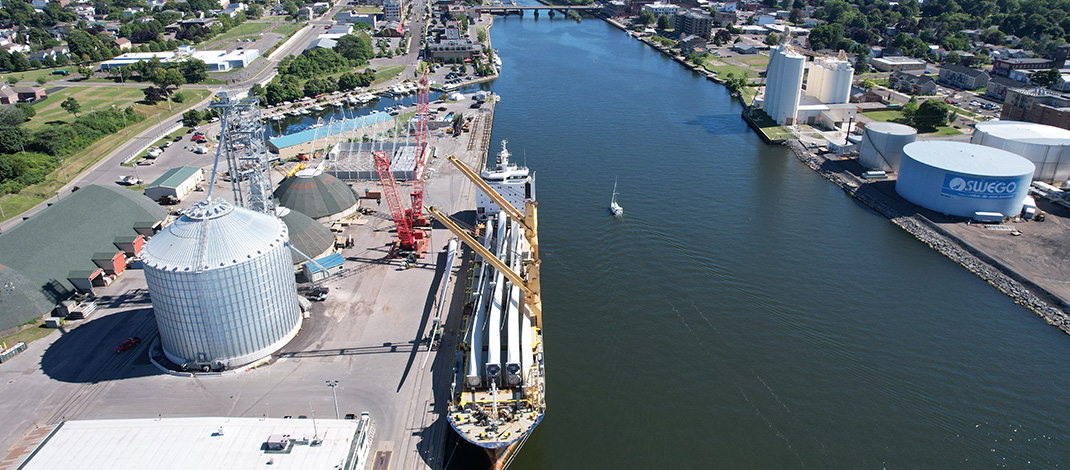By Ken Sturtz

Early one morning in December 2017, members of the Port of Oswego Authority’s board of directors called Bill Scriber into the conference room at the port’s offices on the water in the city of Oswego for a hastily called meeting.
The port’s executive director had resigned suddenly and the board wanted Scriber, who was manager of logistics and administrative services at the time, to serve as acting director.
“I had no choice,” he said. “They basically said you’re taking it over.”
Five years after taking over during a moment of turmoil, the Port of Oswego is thriving under Scriber’s leadership.
The port handled a record 581 million tons of cargo last year, a 300% increase from the previous year.
It has received the prestigious Great Lakes/St. Lawrence Seaway Pacesetter Award, which recognizes ports for major increases in cargo shipping, three of the last four years. And millions of dollars in projects in Oswego Harbor have expanded and enhanced the port’s infrastructure.
Scriber believes in the port’s ability to be an economic engine for the region and has been a driving force behind much of its recent growth. He’s pushed the port to develop a strategic vision and to expand and diversify its revenue streams.
“This is my passion,” Scriber, 65, said. “I’m a local person who truly believes in the value of the Port of Oswego as both a job creator and an economic catalyst and a commercial entity that has almost unlimited ability to grow business in the area.”
Scriber grew up in Parish and was the first in his family to go to college when he enrolled at SUNY Oswego in 1976, studying political science with a focus on public policy and administration. He became the youngest town supervisor in the state when he was elected supervisor in Parish.
He later joined the Army. He graduated from the Army’s logistics school and was responsible for moving everything from guns and ammunition to tanks (he can still tell you where you need to place your pallets on a military transport aircraft). He served in the Special Operations Command during Desert Storm.
He left the Army after eight years and went to work for a logistics company in Syracuse, rising to become an operations manager. He later served as elections commissioner at the Oswego County Board of Elections for 13 years.
In 2009, a management position at the port opened up. Logistics had always been his passion and he decided to try for it, sitting through six hours of civil service exams. He spent the next eight years as manager of logistics and administrative services for the port.
Scriber said that when he became acting director in 2017, the port was in turmoil. It had churned through three executive directors during his time there and lacked a clear sense of direction. The port hadn’t won a Pacesetter Award, it was hemorrhaging customers and its revenue wasn’t where it should have been, he said.
“It was disheartening at times to see what I was left with,” he said. “I knew I had an impossible mission, I knew it was going to be more difficult than anything I had ever done, but I felt I had to do it because everyone I worked for needed someone to take charge of it and try to turn it around.”
Scriber’s first priority was to calm things down and refocus the port on its business. He began working to attract new customers and renegotiate leases more favorable to the port. For most of the year he was acting director, he was still doing his old job and the commitment quickly gobbled up his free hours.
“My wife would tell you there were days I came home that it was hard for me not only to leave the port behind in my mind but to leave the port,” Scriber said.
For all the challenges he faced, Scriber said he had realized over the tenure of the three previous directors that the port had a solid core group of people working there.
“What they needed was a focused direction of where we were going to go and a leader who really believed not only in them but in the value of the port,” he said. “And I truly believe the value of the port has been underestimated in the community and New York for years.”
‘We’re a business entity’

The intersection of the Oswego River and Lake Ontario has been an important location for commerce for hundreds of years, dating to the fur trade. The Oswego branch of the Erie Canal, the super highway of its day, connected Canadian markets with New York City. At one time so many sailing ships choked the mouth of the Oswego River that it was possible to walk across the harbor without setting foot on the water.
Construction of the St. Lawrence Seaway in the 1950s allowed oceangoing ships to traverse all of the Great Lakes, moving cargo to and from the interior of the United States. In the late 1950s, New York state created the Port of Oswego Authority to take advantage.
As a state authority, the port doesn’t receive funding through the state budget; it survives on the revenue it generates. It’s also the last stevedoring port on the Great Lakes, meaning the port owns the docks and equipment and runs the operation rather than contracting a company to do it.
“People say the port,” Scriber said. “But it’s more than a port; we’re a business entity that really contributes to the community in various ways.”
Ports work like giant post offices for businesses that need to buy materials or sell their products. Many companies move goods by truck, but for certain businesses moving cargo by rail or ship is cheaper and easier.
That’s where the port comes in. Businesses in Central New York rely on it to ship everything from salt, fertilizer and petroleum, to potash, aluminum, steel and cement and nuclear power plant components. Two-thirds of the tonnage last year at the port came from 77 ships, but it also moved cargo on 11,000 trucks and 600 railcars and has a warehousing operation.
The port spends more than $2.8 million annually on wages and benefits; it has 30-35 people during peak operations. It supports more than 200 jobs in the area and more than $26 million in economic activity, according to the U.S. Department of Transportation.
“Every single city on the Great Lakes that has a port is vibrant and expanding and has good paying jobs,” Scriber said, citing cities such as Cleveland, Toledo and Duluth. “And because the port is there it creates so much additional asset value to the community.”
For all of the economic benefits of the port, Scriber said that even before he became executive director in 2018, he realized it needed a plan. He worked with the board to develop the port’s first comprehensive plan to ensure the organization had a vision. Part of that vision meant expanding the types of cargo it handled.
“In the past, the port was not diversified,” he said. “We put too many eggs in one basket.”
The port relied heavily for revenue from shipping bulk aluminum for Novelis, but the amount of aluminum shipped varied from year to year. Scriber decided the port needed to expand its grain business to balance out years when aluminum was down.
Grain shipments were a major source of revenue in the past but had declined. The port’s grain facilities were outmoded and inefficient, so the port undertook a $15 million expansion and upgrade, putting up a modern storage silo and creating testing labs to monitor grain quality.
More than 100 farmers ship grain through the port. When it comes in by truck and rail, it’s graded and tested for moisture. The port can unload a truck in under a minute and its storage system now has automated air control and temperature sensors to maintain quality.
The port has also focused on being more competitive by marketing its capabilities to businesses and competing for larger projects. For example, last year it bid on and received contracts for the challenging task of unloading and transporting hundreds of giant windmill components destined for the Southern Tier. It was the port’s first large windmill project in a decade, Scriber said.
“It’s been taking our assets and making them more efficient and stronger,” he said.
Other changes have been less noticeable. Dock upgrades last year allowed asphalt to be transported in bulk by ships. Previously, it was trucked into the area. And Oswego Marina, which the port owns, has received upgrades, including the addition of a 15-site RV park nearby for charter fishing customers. The port is also constructing a $2.1 million deep-water marina near the end of West First Street in Oswego that will include modern docks, bathrooms and a pavilion.
“Our revenue stream is stronger and more diversified than we’ve ever had in the past,” Scriber said.
Having diversified revenue streams helped the port survive the COVID-19 pandemic without resorting to layoffs, which was one of his biggest accomplishments, he said. And it helped the port rebound coming out of the pandemic.
Last year the port signed an agreement with the U.S. Army Corps Of Engineers on a project to deepen Oswego Harbor, which will make it accessible to larger container ships. The federal government also allocated nearly $18 million for critical repairs to the entire harbor breakwater and the foundation of the West Pierhead Lighthouse.
While many of the most dramatic improvements at the port have occurred during Scriber’s tenure, he’s quick to point out that he hasn’t done it alone. He said he now has an excellent team that can run the port even when he’s not there.
Scriber said he tries to set the example for the port’s management team with a relentless work ethic. He typically spends a couple of hours working from home and then a full eight-hour day at the office.
Much of his day is consumed by phone calls, email and courting potential customers in an effort to bring in new business. And he’s often working on grant applications (the port doesn’t have a dedicated grant writer) that have helped pay for millions of dollars in improvements. His one bit of down time is usually when he eats lunch, packed by his wife, at his desk.
He doesn’t consider himself a micromanager but he likes to be hands-on, getting away from his desk when possible. That means getting out in the field to see how things are working or not working. Scriber will still be on site when a ship or barge comes in to be unloaded.
“I learned a valuable lesson in my military career and business,” he said. “You never lead from the back, you lead from the front.”
And he still has plans for the port’s future. The new marina on West First Street is finishing up and the break-water repairs and harbor-deepening are scheduled to begin soon.
Scriber is finishing a grant application that would allow the port to expand its rail operations and he said the port is in the planning stages for building a new heated warehouse that’s solar-powered. The port is also preparing for an increase in business shipping construction materials when Micron Technology begins building its semiconductor plant nearby in Onondaga County.
“It all goes back to my passion for the port, I have a driving passion for what I do,” he said. “I saw a port that could be greater than it was at the time.”




